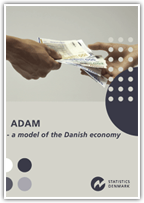Standard multipliers
The multiplier experiments are carried out by changing one or a few of the exogenous variables. Then the model is simulated to calculate the effect on the endogenous variables. There is no provision for possible ties between the exogenous variables. This means that one has to be careful when interpreting the experiments as real world economic events are rarely confined to changes in one exogenous variable.
All experiments expand economic activity. In some experiments the effect is temporary and in others the effect is permanent. In general, a demand shock in ADAM like an additional public purchase of goods, affects production and employment in the short run. However, in the long run a demand shock has no effect on employment. In contrast, a supply shock such as an increase in the labor force has a permanent effect on employment. This is in line with most models of a small open economy with a fixed exchange rate and a Phillips curve.
There is no monetary reaction function and there is no fiscal reaction function in ADAM, which should be taken into consideration when comparing to models for other countries. Also the specific laws and rules modelled in ADAM (e.g. regulatory mechanisms in taxes and transfers) affect the comparison with other countries.
ADAM multipliers - October 2015 (preliminary version)
Starting with the October 2015 version, the labour supply multiplier is also calculated with increased export price elasticity in the model.
The calculations are made with the model version October 2015 using the baseline lang15.
ADAM multipliers - October 2014
The calculations are made with the model version October 2014 using the baseline lang14.
ADAM multipliers - June 2014
From the June 2014 version and onwards, all shocks to economic policy instruments have been scaled to represent 0.1 per cent of GDP at constant prices. For multipliers on earlier model versions, the policy shock represented 1000 mill. Dkr. at constant prices.
The calculations are made with the model version June 2014 using the baseline lang14.
ADAM multipliers - July 2013
The calculations are made with the model version July 2013 using the baseline lang13.
ADAM multipliers - October 2012
The calculations are made with the model version October 2012 using the baseline lang13.
ADAM multipliers - December 2009
From the December 2009 version and onwards, two multipliers (the public purchase multiplier and the labour supply multiplier) have also been calculated under a budget constraint to illustrate the consequences of a fiscal rule.
The calculations are made with the model version December 2009 using the baseline lang11.

